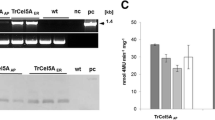Abstract.
A cell suspension culture of a tobacco (Nicotiana tabacum L. cv. Petit Havana) cell line derived from a cultivar transformed with the Tcyt gene from Agrobacterium, which leads to high endogenous levels of cytokinin, has been established. This cell line shows increased cell aggregation, elongated cells and a 5-fold increase in wall thickness. If allowed to carry on growing it can form a single mass without shedding cells into the medium. When analysed at an earlier growth stage, these cultures were found to produce improved levels of vascular nodule formation than in other systems that employ exogenous cytokinin. This differentiation was optimised with respect to sucrose and auxin signals in order to induce maximum production of cells with thickened walls and a morphology characteristic of fibre cells and tracheids, in addition to cells that remain meristematic. In order to establish the validity of this system for studying secondary wall formation, the walls and associated biosynthetic changes were analysed in these cells by chemical analysis of the walls, changes in activities of enzymes of xylan and monolignol synthesis, and expression of mRNAs coding for enzymes of lignin biosynthesis. The wall composition of the transformed cells was compared with that determined for primary walls from a typical untransformed tobacco cell line. Recovery of wall material was 50% greater in the transformed culture. In this material a major difference was found in the pectin fraction where there was a distinct difference in size distribution together with a lower level of methylation for the transformed line, which may be related to increased adhesiveness. There were increased amounts of xylan, although the ratio of xyloglucan to xylan content was not substantially different due to the mixture of cell types. There was also an increase in cellulose and phenolic components. Increased activity of enzymes involved in the synthesis of xylan as a marker for the secondary wall occurred around the time of tracheid differentiation and coincided with a broad peak of cinnamyl alcohol dehydrogenase activity. The expression of mRNAs coding for enzymes of the general phenylpropanoid pathway, phenylalanine ammonia-lyase, cinnamate 4-hydroxylase, catechol O-methyl transferase was relatively constitutive in the cultures while transcripts of ferulate 5-hydroxylase, cinnamoyl CoA-reductase, cinnamyl alcohol dehydrogenase and lignin peroxidase were induced. The walls of the transformed cells also showed considerable differences in the subset of extractable proteins from that found in primary walls of tobacco when these were subjected to proteomic analysis. Many of these proteins appear to be novel and not present in primary walls. However an M r-32,000 chitinase, an M r-34,000 peroxidase, an M r-65,000 polyphenoloxidase/laccase and possibly an M r-68,000 xylanase could be identified as well as structural proteins.
Similar content being viewed by others
Author information
Authors and Affiliations
Additional information
Received: 12 April 2000 / Accepted: 21 June 2000
Rights and permissions
About this article
Cite this article
Blee, K., Wheatley, E., Bonham, V. et al. Proteomic analysis reveals a novel set of cell wall proteins in a transformed tobacco cell culture that synthesises secondary walls as determined by biochemical and morphological parameters. Planta 212, 404–415 (2001). https://doi.org/10.1007/s004250000407
Issue Date:
DOI: https://doi.org/10.1007/s004250000407




